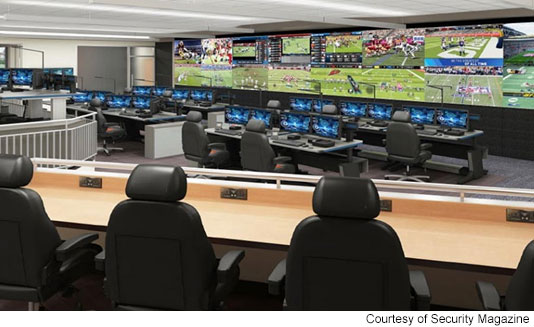
The Super Bowl, one of the most anticipated sporting events globally, commands not only the attention of millions of viewers but also necessitates meticulous security arrangements. As the vibrant city of Las Vegas hosted this colossal event, ensuring safety became paramount amid the glitz and glamour of the entertainment capital.
The U.S. Department of Homeland Security classified Super Bowl 58 (SB58) as a Special Event Assessment Rating Level 1 event, which means it qualified it for extensive federal support. More than 350 DHS personnel (overall more than 750 federal personnel) were involved in dedicated security operations in and around the Las Vegas area and more than 60 Transportation Security Administration explosive detection canines and their handlers were in town to assist with security operations at key venues throughout Las Vegas as well as at Harry Reid International Airport. These working canines are specially trained to detect explosives and explosive components. This would be in addition to the thousands of gig workers and volunteers in security, coming from outside Southern Nevada.
With thousands flocking to witness the extravaganza, security measures must be robust and comprehensive. The security blueprint encompasses various elements ranging from physical barriers to advanced surveillance technologies and human intelligence.
First and foremost, perimeter security forms the outer layer of defense. Surrounding the venue with sturdy barriers and checkpoints equipped with metal detectors and x-ray scanners helps screen for prohibited items, ensuring the safety of attendees. Additionally, employing explosive detection dogs adds another layer of security, capable of swiftly identifying potential threats.
Inside the venue, a sophisticated network of surveillance cameras, both visible and concealed, provides real-time monitoring of activities. This extensive CCTV coverage, coupled with analytics software, enables security personnel to detect suspicious behavior and respond promptly, mitigating risks before they escalate. Furthermore, deploying drones equipped with high-resolution cameras enhances aerial surveillance, offering comprehensive coverage of large areas. The NFL Global Security Operations Center (GSOC) is an integral part of keeping the Super Bowl safe.

Besides the NY facility, which is pictured above, satellite GSOCs were operated at Caesars Palace, which hosted the 1500+ NFL employees, and at Allegiant Stadium. The GSOG worked in conjunction with the Southern Nevada Counter Terrorism Center, FBI, and DHS partners.
Besides the stadium itself, security was needed at some 30+ NFL-sanctioned events, along with over 300 events throughout the city. Security was also heavily deployed at Lake Las Vegas, 25 miles from the SB58 site, where the Chiefs and 49ers were staying the week before SB58. This also necessitated police escorts of the team busses to and from the stadium and practice facilities.
Human intelligence plays a pivotal role in preempting security threats. Trained security personnel, including uniformed officers and plainclothes agents, blend seamlessly with the crowd, adept at identifying and intercepting any suspicious individuals or activities. Additionally, establishing communication channels with local law enforcement agencies and intelligence services facilitates information sharing, enabling proactive measures to counter potential threats.
Cybersecurity emerges as an indispensable component in safeguarding the Super Bowl. With the proliferation of digital technologies, securing networks and systems against cyber threats is imperative to prevent disruptions and protect sensitive data. Implementing robust encryption protocols, deploying firewalls, and conducting regular security audits fortify the digital infrastructure, ensuring the integrity and confidentiality of critical information.
Moreover, crowd management assumes significance in maintaining order and safety amidst the sea of spectators. Designated entry and exit points, along with clear signage and staff assistance, streamline the flow of attendees, minimizing congestion and potential security vulnerabilities. Additionally, crowd control barriers and trained personnel proficient in crowd management techniques mitigate the risk of stampedes or unruly behavior.
Collaboration with local authorities and emergency services was essential for a coordinated response to any contingencies. Establishing command centers equipped with communication systems facilitates seamless coordination between various agencies, enabling swift responses to emergencies. Conducting regular drills and simulations ensures readiness to handle various scenarios, from medical emergencies to security breaches, with efficiency and efficacy.
Public awareness campaigns, such as no-fly zones and traffic closures play a crucial role in fostering a culture of vigilance among attendees. Informing spectators about security protocols, emphasizing the importance of reporting suspicious activities, and providing guidance on emergency procedures, empower individuals to contribute to the collective safety effort. Additionally, leveraging social media platforms and mobile applications to disseminate real-time updates and emergency notifications enhances situational awareness among attendees. With many high-profile celebrities, politicians, government officials (and of course Taylor Swift)
Beyond the physical realm, ensuring the psychological well-being of attendees is paramount. Implementing measures to address potential threats, such as terrorism or mass shootings, while maintaining a welcoming and celebratory atmosphere requires a delicate balance. Communicating openly about security measures, providing support services for those in distress, and fostering a sense of community solidarity contribute to a positive and resilient event experience.
In conclusion, securing the Super Bowl in Las Vegas demanded a multi-faceted approach that combined physical, digital, and human-centric strategies. From perimeter defenses to cyber safeguards, and crowd management to public awareness, every aspect of security converged and created a safe, spectacular, and superb economic event for Las Vegas. By embracing innovation, collaboration, and preparedness, Las Vegas, the NFL, and security partners ensured that the Super Bowl remains a symbol of excellence, excitement, and safety for years to come (and maybe SB in 2027 in Las Vegas!!).
